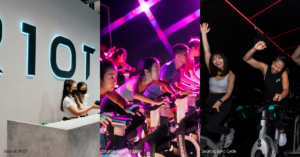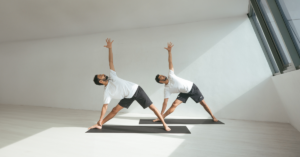Wellness
Always Working in front of a Computer? Start these Healthy Habits, now!
Office workers, we need to talk. We spend 8 hours a day hunched in front of computers. While emails and...
By: Dedet Panabi / January 22, 2020

Office workers, we need to talk. We spend 8 hours a day hunched in front of computers. While emails and Excel sheets may not count as “hazardous objects” the time we spend in front of screens (and hunched in our desks) can hurt our health. Here’s what we need to know — and more importantly, what we need to do — for us office rats to stay healthy and happy.
Blue Light
You already know how sun exposure can cause dark spots, discoloration and early wrinkles. But screen exposure can be just as bad! Laptops, phones, TV and even indoor lights emit blue light — short but powerful light waves that can break down collagen and elastin, and damage the eyes. Most of our blue light exposure comes from the sun, but yep: gadgets and lightbulbs emit it too.
To be fair, blue light does have its benefits. It helps regulate our circadian rhythms or body clock — but that was when we got our blue light from the sun, and not from artificial sources like gadgets. Since most of us bring our phones to bed, or watch videos on tablets to unwind after dinner, we’re getting more blue light than Nature intended. Office workers are bathed in blue light round-the-clock. We work in front of computers, and we fall asleep in front of phones.
What you can do:
- Turn on your phone’s Blue Light setting. Samsung Galaxy phones have a blue light filter option now., which you can activate by swiping down and looking at your notification shade. For other Android and Apple tablets and phones, go to Settings > Display.
- Use Beyond Sun Protection sunscreen (read about the launch our full Editor’s review). Aside from blocking UV rays, it filters out 54% of Blue Light — the highest proven protection against it. You can order from their website, or buy from authorized clinics.
Carpal Tunnel Syndrome
Whenever we type, we force our bodies into a very unnatural position: shoulders hunched, arms hanging, fingers scanning the keyboard while our wrists rest at an uncomfortable angle. We’re so focused on working that we don’t notice the discomfort or muscle strain — until our nerves are damaged, and we feel pain.
What you can do:
Every hour, do a short wrist exercise that can help relax your hand and wrist muscles.
- Shake it out. Jazz hands!
- The Stop Sign. Make a fist. Slide your fingers up until they point toward the ceiling, like you’re telling someone to stop. Repeat 5-10 times.
- The Fan. Make a fist. Fan your fingers out — stretch them as far as you can. Repeat 5-10 times.
Back and neck pain
Most office workers use the wrong chair, which is set at the wrong height. We’re frozen into a hunched position, getting up only for lunch when we sit down (again!) in another bad chair and table set-up. It doesn’t get better at home: lumpy pillows and mattresses force us to sleep at odd positions. And you wonder why your back hurts?
What you can do:
- Adjust your office chair’s height so you’re not hunched over the table. Also make sure your knees are a little higher than your lips when you sit. A small pillow can help support your back, and prompt you to sit up straighter instead of leaning forward or backward — posture is key for preventing back pain!
- Schedule regular tension-relieving massages. Check our list of the 3 best massages for lower back pain, and Beauty Insider’s directory of Singapore spas to find one near you!
- Get up and stretch! Every hour, stand up and walk around, or just twist your torso and touch your toes a few times.
Eye fatigue
Our eyes are more powerful than any camera: adjusting to changes in light, focusing and defocusing, and sending all that information to our brain. We also forget to blink! Normally, we blink about 15-20 times a minute, which spreads tears evenly over your eyes. But researchers have found that people blink less than half as often when they’re reading, watching, or playing on a screen.
What you can do:
- Position your screen properly. It should be an arm’s length (about 25 inches) away from your face. If you’re using a laptop, tilt the monitor so the center of the screen is 10 to 15 degrees below eye level.
- Reduce glare with a matte screen filter. You can find them at any computer store! You can also adjust your screen’s brightness levels.
- Follow the 20-20-20 rule. Every 20 minutes, look at an object at least 20 feet away for at least 20 seconds.
Hidden dehydration
Don’t wait until you’re thirsty to drink water! Your body signals that it’s low on fluids through other symptoms that we often dismiss, like headaches and poor concentration. (Read about the 7 signs of hidden dehydration.)
What you can do:
- Take water breaks often, and while you’re at it — wash that mug! Our article on the germs in office mugs and water bottles will make you go running to the sink, fast!
- Download an app that helps you track both your meals and the number of glasses you had each day.
- Do the 1:1 rule. Drink a glass of water for every equivalent of a drink that is a diuretic (coffee, tea or alcohol). Diuretics make you lose water (i.e., make you want to pee).















